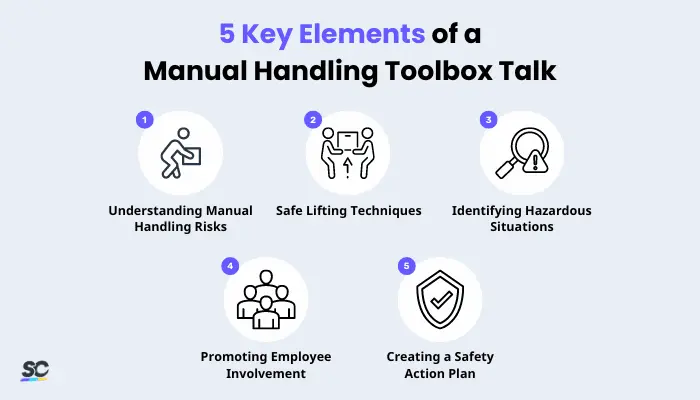What is a Manual Handling Toolbox Talk?
A manual handling toolbox talk is a short and interactive training session to promote and implement safe manual handling practices in the workplace. Typically, it’s conducted in a group setting and led by a supervisor, manager, or safety professional to raise awareness about manual handling risks and provide guidance on safety protocols for injury prevention.
Why Conduct a Manual Handling Toolbox Talk
Generally, toolbox talks are a vital component of any workplace safety program. They provide an opportunity to educate employees and create a culture of safety that benefits both individuals and the organization as a whole.
Having specific safety discussions or briefings is also important to cater to different kinds of tasks, jobs, and industries. One example is a manual handling toolbox talk, which aims to improve the understanding of the risks involved in it and ensure best practices are implemented. Conducting this safety toolbox is crucial due to the following:
- Injury Prevention
- Increased Awareness
- Compliance with Regulations
- Empowerment
- Improved Productivity
- Feedback and Communication
- Consistency in Training
- Prevention of Long-Term Health Issues
In conjunction with a manual handling toolbox talk, a hand safety toolbox talk must also be conducted for a holistic understanding of the safety practices that must be implemented in the workplace.
What to Cover in Toolbox Talks for Manual Handling
Commonly, the topics included in this type of toolbox talk are the following:
- Understanding the definition of manual handling
- Identifying potential hazards
- Recognizing the importance of proper techniques
- Encouraging team participation
- Introducing tools and equipment
- Explaining the employer’s responsibilities
- Promoting a safety culture
5 Key Elements of a Manual Handling Toolbox Talk

5 Key Elements of a Manual Handling Toolbox Talk
To ensure an effective manual handling safety toolbox talk, organizations and safety professionals must be able to incorporate key elements and topics in the discussion. These include the following:
- Understanding Manual Handling Risks – This focuses on explaining what manual handling is and the types of activities involved, such as lifting, carrying, pushing, or pulling objects. Participants also learn about the potential injuries and health hazards that can arise from improper manual handling, emphasizing the importance of being aware of these risks.
- Safe Lifting Techniques – This covers the proper techniques for lifting and handling objects to minimize the risk of injuries. Through demos and practice exercises, participants are shown how to:
- use their leg muscles;
- maintain a neutral spine position; and
- avoid twisting or bending their back when lifting heavy objects.
- Identifying Hazardous Situations – In this aspect, participants are taught to recognize heavy or awkward loads, cramped workspaces, slippery floors, and other hazards. Understanding such helps employees take proactive measures to avoid or address unsafe conditions.
- Promoting Employee Involvement – This encourages active participation from employees during the toolbox talk. Facilitators can do so by encouraging questions, sharing personal experiences, and discussing challenges faced during manual handling tasks.
- Creating a Safety Action Plan – This involves developing a safety action plan to implement the knowledge gained from the toolbox talk into daily work practices. This may include setting up clear guidelines for safe procedures, encouraging the use of mechanical aids or equipment, and designating specific responsibilities for safety-related tasks.
Improve your EHS Management
Cultivate a safe working environment and streamline compliance with our EHS solutions.
Explore nowHow to Conduct Toolbox Talks on Manual Handling
Employers and safety officers are responsible for ensuring that employees are well-acquainted with safety procedures. Hence, they must put time and effort into carefully planning and conducting toolbox talks.
As a quick guide, here’s how to make sure such safety briefings are done effectively:
- Prepare the content of the toolbox talk in advance. Ensure it covers key topics to emphasize the importance of safe manual handling.
- Conduct the manual handling toolbox talk at the worksite so that employees can relate the information to their daily tasks. Ensure a comfortable space with minimal distractions for participants.
- Communicate the date, time, and location of the toolbox talk to all key participants. Encourage attendance and make it clear that participation is essential for workplace safety.
- Begin the talk by introducing the topic and its relevance to the employees’ work. Engage the audience from the start by asking questions or sharing relatable scenarios related to manual handling.
- Start by explaining what manual handling entails and the potential risks involved. Use visuals, statistics, and practical toolbox talk examples to make the information more impactful.
- Show participants the correct lifting techniques and encourage volunteers to practice these for hands-on learning.
- Discuss common hazardous situations related to manual handling and empower employees to identify potential hazards in their own work areas.
- Allow employees to share their experiences, challenges, and suggestions related to manual handling tasks. Remember to foster open communication.
- Be prepared to answer any questions or concerns raised by employees during the talk and provide additional information if needed.
- Collaboratively create a safety action plan with the employees by discussing strategies on safe manual handling practices, the use of mechanical aids, and the importance of reporting hazards.
- Conclude by summarizing the main points and expressing gratitude to the participants for their active engagement.
- After the talk, follow up with employees to ensure they’re applying the knowledge gained. Monitor the workplace to see if there are any improvements in manual handling practices.
Create Your Own Manual Handling Toolbox Talk Template
Eliminate manual tasks and streamline your operations.
Get started for FREEExamples
To guide you through creating and conducting effective toolbox talks for manual handling, here are a few examples you can use:
Manual Handling Toolbox Talk Example for Lifting
Topic: Safe Lifting Techniques – Your Guide to Preventing Injuries
Good day, everyone!
Today, we’re here to talk about one of the most common activities in the workplace: lifting. Whether it’s boxes, equipment, or supplies, we all engage in lifting tasks daily. However, improper lifting techniques can lead to serious injuries, affecting both your well-being and our productivity as a team. So, let’s take a moment to learn and refresh our knowledge of safe lifting techniques:
- The first rule of safe lifting is to remember the L.I.T.E principle, which stands for Load, Individual, Task, and Environment.
- Before lifting, always assess the load by checking its weight and shape.
- When dealing with heavy or bulky loads, never hesitate to ask for help.
- Ensure your pathway is free of obstacles by removing any tripping hazards to avoid accidents while lifting.
- Move closer to the load to maintain balance and control while lifting.
- Be aware of your surroundings and any potential hazards that may affect your lifting task, such as slippery or uneven surfaces.
- Plan your lifting technique, think about where you’ll place the load, and choose the best way to handle it safely.
- Before engaging in lifting tasks, warm up your muscles with some simple stretches to help reduce the risk of strains and sprains.
- Whenever possible, use mechanical lifting aids like trolleys, dollies, or forklifts to reduce the physical strain on your body.
- If you notice any unsafe lifting practices or hazardous conditions, don’t hesitate to report them to your supervisor or safety representative.
Remember, your safety is our top priority, and proper lifting techniques are crucial to avoiding injuries. Let’s make sure we incorporate these safe lifting practices into our daily routines and encourage our colleagues to do the same.
Thank you for your attention, and please feel free to ask any questions or share your thoughts on safe lifting. Stay safe and work smart!
Manual Handling Toolbox Talk Example for Carrying
Topic: Carrying with Care – Preventing Strains and Injuries
Good day, everyone!
Today, we’re going to discuss an essential aspect of manual handling: carrying. Many of our daily tasks involve moving objects from one place to another, and carrying them incorrectly can lead to strains and injuries. So, let’s take a moment to learn about safe carrying techniques to protect ourselves and our team:
- Before you start carrying, take a moment to assess the load by:
- ensuring the load is within your safe carrying capacity—otherwise, seek help or use mechanical aids; and
- verifying the load is secure and won’t shift or tip during transport.
- Always plan your carrying route in advance to avoid obstacles and hazards.
- Choose the appropriate grip for the load you’re carrying. For small objects, use a firm, full-hand grip. For long or awkward objects, use both hands and balance the load evenly.
- Carry the load as close to your body as possible to maintain balance and reduce strain on your back.
- Keep your back straight and shoulders back while carrying. Avoid leaning forward or backward, as this can increase the risk of injury.
- Never twist your body while carrying a load and instead pivot with your feet to change direction.
- If you’re carrying a heavy load over a long distance, take regular breaks to rest and stretch your muscles.
- For large or bulky loads, don’t hesitate to ask a colleague for assistance to make carrying safer and more manageable.
- Ensure you’re wearing sturdy, closed-toe shoes with good traction to prevent slipping or tripping.
- If you encounter any hazards or potential risks while carrying, report them to your supervisor or safety representative immediately.
- When feasible, use trolleys, carts, or other mechanical aids to transport heavy or awkward loads to reduce the physical strain on your body.
- After completing a carrying task, take a moment to stretch your muscles to prevent stiffness and promote flexibility.
Remember, proper carrying techniques are crucial to preventing strains and injuries. By incorporating these safe practices into our daily routines, we create a safer and healthier work environment for everyone.
Thank you for your attention, and let’s make sure we all carry with care and look out for one another’s well-being. If you have any questions or want to share your experiences, please feel free to do so. Stay safe, and keep up the great work!




